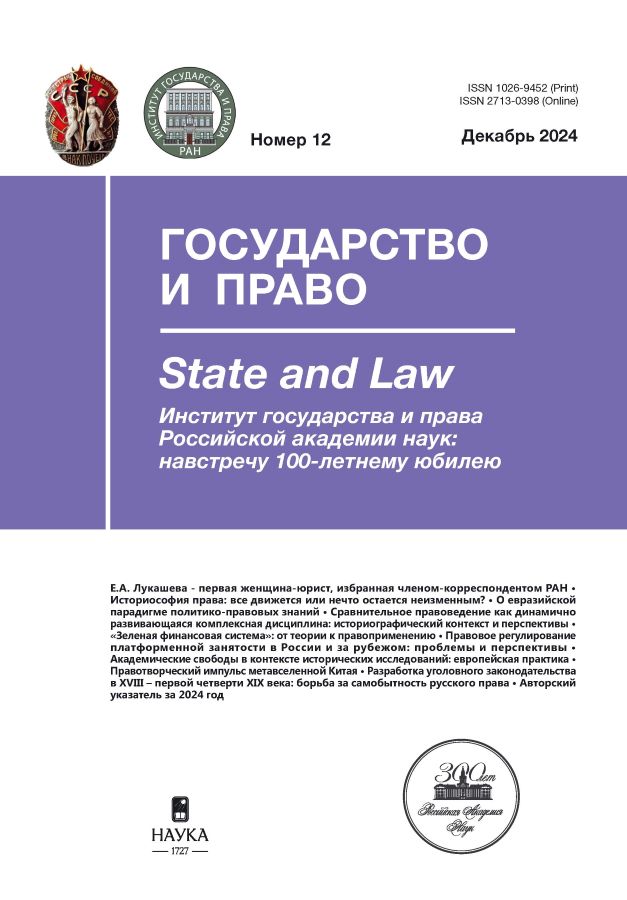Working time and rest time in the era of digitalization: opposition or comparison?
- Autores: Boldyrev V.A.1, Klepalova Y.I.1
-
Afiliações:
- Russian State University of Justice
- Edição: Nº 12 (2024)
- Páginas: 111-118
- Seção: Labor law and digital economy
- URL: https://kazanmedjournal.ru/1026-9452/article/view/681494
- DOI: https://doi.org/10.31857/S1026945224120113
- ID: 681494
Citar
Texto integral
Resumo
Based on the content analysis method, the demand for the categories “working time” and “rest time” in legal science is characterized. It is noted that the architectonics of codified labor legislation and legal definitions lead to the opposition of relevant concepts, giving rise to cognitive dissonance. The comparison method is more logical given the existence of a period of temporary incapacity for work, which cannot be attributed to either working time or rest time. It is emphasized that student leave, maternity leave, and child care leave do not correspond to the definition of rest time, since positive law provides for the use of the appropriate time for certain socially significant purposes, and not at the employee’s own discretion. The norms of International Law (ILO conventions) and constitutional norms are logically based on the principle of comparing working time and rest time. The task of legal science and education is to formulate a lawyer’s understanding of an employee’s time as a complex structural phenomenon containing components that do not fit into the dichotomous (polarized) division resulting from the architectonics and definitions of codified labor law.
Texto integral
Sobre autores
Vladimir Boldyrev
Russian State University of Justice
Autor responsável pela correspondência
Email: vabold@mail.ru
North-Western Branch, Doctor of Law, Associate Professor, Professor of the Civil Law Chair
Rússia, 5 Aleksandrovsky Park, 197046 St. PetersburgYuliya Klepalova
Russian State University of Justice
Email: klepalova.yulia@yandex.ru
North-Western Branch, PhD in Law, Associate Professor, Associate Professor of the Civil Law Chair
Rússia, 5 Aleksandrovsky Park, 197046 St. PetersburgBibliografia
- Bakhtina N. N. Professional time of a subject as a basis for psychological classification of professions // Herald of the North-Eastern State University. 2008. No. 10. Pp. 69, 70 (in Russ.).
- Gabov A. V. Digital platform as a new legal phenomenon // Perm Jurid. Almanac. 2021. No. 4. Pp. 61, 62 (in Russ.).
- Gomperts U. Think like an artist, or How to make life more creative without cutting off your ear / transl. from English by I. Stam. M., 2021. P. 239 (in Russ.).
- Drachuk M. A. Suspension of an employment contract (in relation to the rules on rest time and labor discipline) // Herald of the Perm University. Legal sciences. 2010. No. 1 (7). P. 70 (in Russ.).
- Dubynin V. The brain and its needs: from nutrition to recognition. M., 2022. Pp. 504–507 (in Russ.).
- Karmanova Z. Ya. Principles of phenomenological linguistics. Kaluga, 2022. P. 373 (in Russ.).
- Kleandrov M. I. Digital economy and problems of the justice mechanism // Economy. Right. Society. 2018. No. 1 (13). P. 33 (in Russ.).
- Prygin G. S. Consciousness and time. Is subjective time objective // Herald of the Udmurt University. Ser.: Philosophy. Psychology. Pedagogy. 2019. Vol. 29. No. 2. P. 182 (in Russ.).
- Savenkov A. N. The global crisis of modernity as a subject of Philosophy of Law // State and Law. 2019. No. 4. P. 10 (in Russ.).
- Savenkov A. N. The state and law in the period of crisis of modern civilization. M., 2020. P. 314 (in Russ.).
- Savenkov A. N., Gorban V. S. Modern psychology of law and legal views of L. I. Petrazhitsky // Psychological Journal. 2019. Vol. 40. No. 3. P. 89 (in Russ.).
- Simonov P. The motivated brain. Higher nervous activity and natural scientific foundations of general psychology. SPb., M., Minsk, 2023. P. 51 (in Russ.).
- Filipova I. A. Neurotechnologies in law and law enforcement: past, present and future // Law enforcement. 2022. Vol. 6. No. 2. P. 43 (in Russ.).
- Chucha S. Yu. Features of the legal regulation of workers’ labor when introducing special measures in the field of economics // State and Law. 2023. No. 9. P. 197 (in Russ.).
- Chucha S. Yu. Suspension of an employment contract // State and Law. 2023. No. 6. P. 94 (in Russ.).
- Chucha S. Yu. Theory of labor relations in the conditions of transformation of the sphere of labor: designation of the problem // State and Law. 2023. No. 3. P. 155 (in Russ.).
- Hall J. Some Basic Questions Regarding Legal Classification for Professional and Scientific Purposes // Journal of legal education. 1953. Vol. 5. P. 331.
- Loeng S. Various ways of understanding the concept of andragogy // Cogent Education. 2018. Vol. 5. Iss. 1. Art. 1496643. P. 5.
- Miller G. A. The cognitive revolution: a historical perspective // Trends in Cognitive Sciences. 2003. Vol. 7. No. 3. Pp. 141–144.
- Pepper S. C. Emergence // The Journal of Philosophy. 1926. Vol. 23. No. 9. P. 242.
Arquivos suplementares










